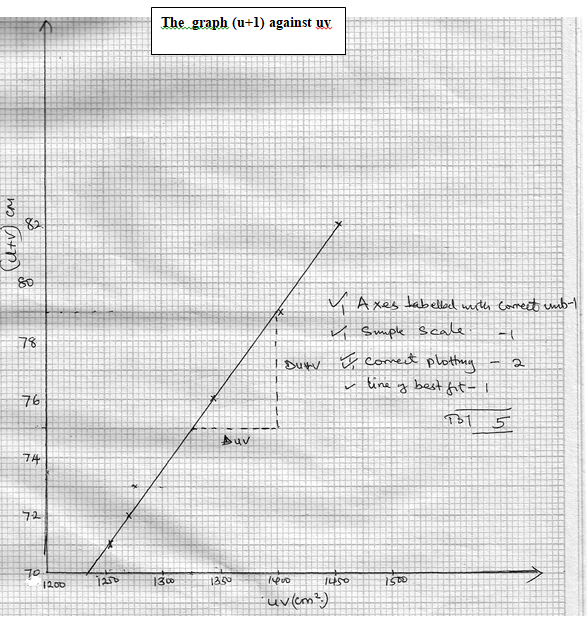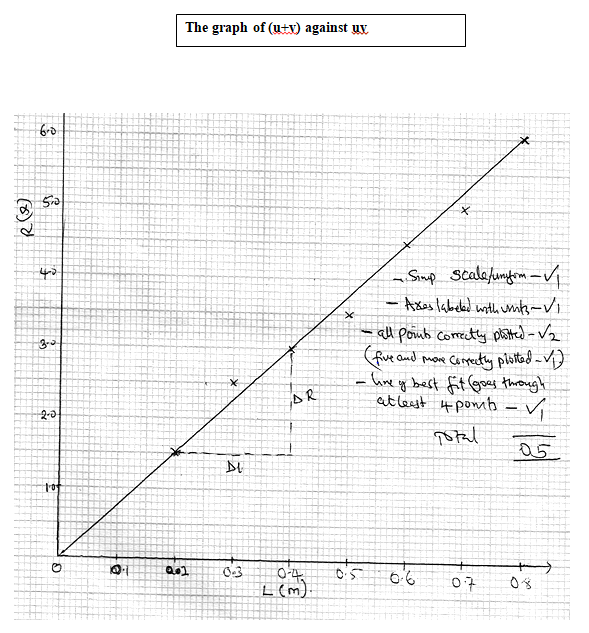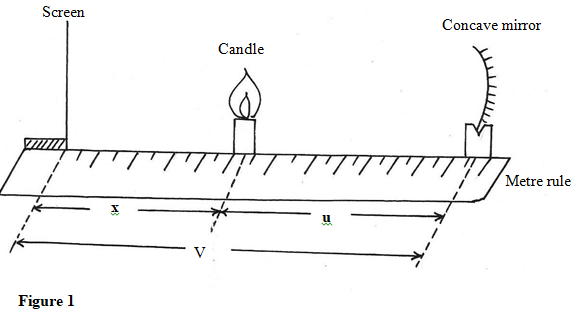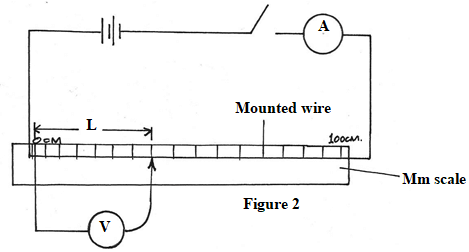232/3
PHYSICS
Paper 3 (Practical)
FORM 3
INSTRUCTIONS TO THE CANDIDATES:
- Write your name and index number in the spaces provided above.
- Sign and write the date of the examination in the spaces provided above.
- You are supposed to spend the first 15 minutes of the 2 ½ hours allowed for this paper reading the whole paper carefully.
- Marks are given for a clear record of the observation actually made, their suitability, accuracy and the use made of them.
- QUESTION 1
- Apparatus
- Concave mirror on a lens holder
- Screen
- Metre rule
- Candle
Proceed as follows;- Set the apparatus as shown in fig 1
- Place the candle at a distance x= 5.0cm from the screen
- Move the mirror to and from to focus a clear, sharp image of the candle on the screen
- Measure and record the distance u between the mirror and candle and the distance v between the screen and the mirror.
- Repeat the experiment for other values of x and complete the table below (table 1)
X(cm) 5.0 10.0 15.0 20.0 25.0 30.0 U(cm) V(cm) (u + v)cm Uv(cm2) - Plot a graph of (u+v) (y axis) against uv (5mks)
- Determine the slope S of the graph (5mks)
- Using the value of S obtained in VII above, determines the value of f, the focal length of the mirror. (2mks)
- Given that R = 4f determine the value of R (2mks)
S2
- Apparatus
- QUESTION 2
You are provided with the following- An ammeter (0-1A)
- A voltmeter
- A wire mounted on a mm scale
- A switch
- A long wire with a crocodile clip at one end (crocodile clip to be used or a jockey)
- 2 new size D dry cells and a cell holder
- A micrometer screw gauge(may be shared)
- Six connecting wires, two with crocodile clips at the end
Proceed as follows- measure the diameter d of the mounted wire at 3 different points
Average diameter= mm (1mk) - Set up the apparatus as shown in the circuit diagram in fig 2
- Close the switch and tap the mounted wire with crocodile chip as shown in the circuit. Ensure that both meters show possible deflection. Open the switch
- Tap the wire at L= 20cm, close the switch, and record in the table provided the ammeter and the voltmeter reading.
- Repeat procedure in IV for the other values of L, shown in the table below and complete the table. (8mks)
L (cm) L (m) V( volts) I R= V(Ω)
I20 30 40 50 60 70 80 - Plot the graph of R(y-axis) against Lcm (grid provided)
- Determine the slope of the graph (3mks)
- Given that R=lL the where A is the cross sectional area of the wire and ρ is a constant
A
for the material of wire. Determine the value of the constant ρ
- measure the diameter d of the mounted wire at 3 different points
REQUIREMENT (CONFIDENTIAL)
NB: Physics teachers should ensure that candidates do not get prior knowledge of the content of this paper
Question 1
Each student should have:
- A concave mirror of f = (15-20cm) on a lens holder
- A screen
- A metre rule
- A candle and a match box The match box may be shared)
Question 2
Each student should have:
- An ammeter (0-1A)
- A voltmeter (0-2.5V) or (0-5V)
- A switch
- A nichrome wire (29-28mm) mounted on a mm scale -1 metre long
- Along wire with a crocodile clip at one end (or a jockey)
- Two new size D dry cells and cell holder
- Six connecting wires, two with crocodile clips at one end
- A micrometer screw gauge (may be shared)

MARKING SCHEME
Question1
-
- Table results
X(cm) 5.0 10.0 15.0 20.0 25.0 30.0 U(cm) 33.0 31.0 29.0 28.0 27.0 26.0 V(cm) 38.0 41.0 44.0 48.0 52.0 56.0 (u + v)cm 71.0 72.0 73..0 76.0 79.0 82.0 Uv(cm2) 1254 1271 1276 1344 1404 1456 - See the graph on the grid below

- Slope = D u + v
D uv
= (78 – 75)cm (must be shown on the graph.)
1400 -1328
= 4
72cm
=18cm-1
= 0.05556cm-1
- Table results
- 1/f = 1/u + 1/v
1/f = u +v
Uv
u+v = uv/f √1 correct evaluation
Slope of the graph of u+v against uv is a straight line with a slope of 1/f hence
1/f = 0.05556cm2
F= 18cm√ 1 - R = 4 x 18cm√1 correct substitute
0.05556cm-1
R = 23328cm2√ 1 correct answer
Question2
- Average diameter = 0.35 +n 0.01 mm
-
L (cm) L (m) V( volts) I R= V(Ω)
I20 0.2 0.3 0.20 1.5 30 0.3 0.5 0.20 2.5 40 0.4 0.6 0.20 3.0 50 0.5 0.7 0.20 3.5 60 0.6 0.9 0.20 4.5 70 0.7 1.0 0.20 5.0 80 0.8 1.2 0.20 6.0 - See the graph on the grid provided

- Slope = DR
Dt√ 1
= (3.0 – 1.5)Ω
0.4 – 0.2 M √1
= 1.5Ω
0.2M
= 7.5Ω M-1
-
- R = R ℓ L/A
A =r2
=3.142 x 0.35 x 0.35
2 2
A= 0.09622x10-6 m2√ 1 for area of cross-section of the wire slope of the graph e/A
E = slope x a √1
= 7.5 Ω m-1 x 9.622 x10-9 m2
= 7.2165 x 10-5Ω M√1 with correct units
Download Physics Paper 3 Questions and Answers with Confidential - Form 3 End Term 3 2020/2021.
Tap Here to Download for 50/-
Get on WhatsApp for 50/-
Why download?
- ✔ To read offline at any time.
- ✔ To Print at your convenience
- ✔ Share Easily with Friends / Students



